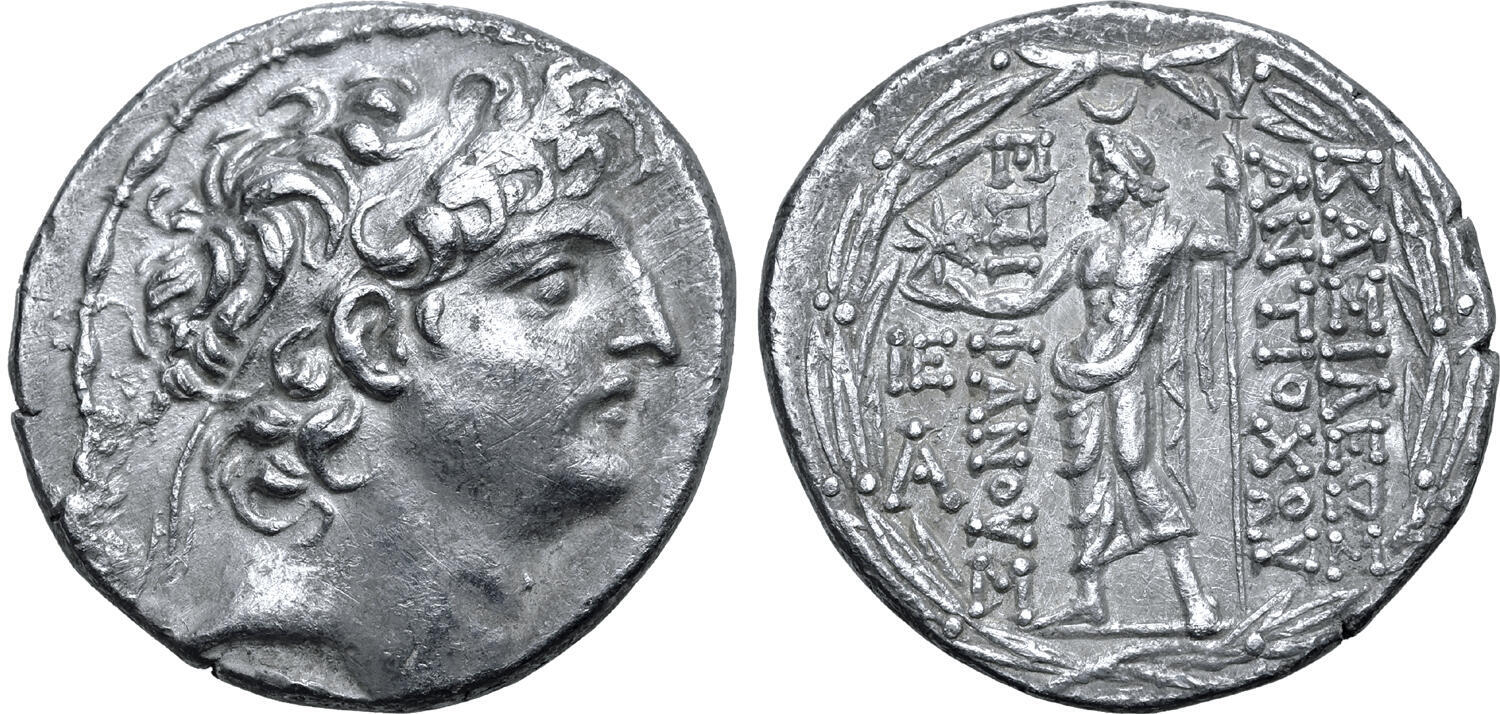H 305 - Syria (uncertain mint) (Antiochus VIII), silver, tetradrachms (121-96 BCE)
From SILVER
121 BCE - 96 BCE Silver 6,595 kg
Description
| ObverseInscription or printing placed on the obverse.: | Diademed head to right. |
| ReverseInscription or printing placed on the reverse.: | ΒΑΣΙΛΕΩΣ ANTIOXOY EΠΙΦΑΝΟΥΣ (Greek).ΒAΣΙΛEΩΣ ΑNTIOXOY EΠIΦANOYΣ, Zeus Ouranios, draped, standing facing, head to left, holding star in outstretched hand and long sceptre, crescent above, IE over A in left field, P in inner right field, all within laurel wreath border. |
Mint and issuing power
| MintIdentifies the place of manufacture or issue of a numismatic object.: | Syria (uncertain mint) | Ancient regionAncient region.: | Syria (Seleucis and Pieria) | Modern countryModern country: Turkey | AuthorityIdentifies the issuing power. The authority can be "pretended" when the name or the portrait of X is on the coin but he/she was not the issuing power. It can also be "uncertain" when there is no mention of X on the coin but he/she was the issuing power according to the historical sources: | Antiochus VIII Grypus (Seleucid king, 121/0-97/6 BC), Seleucid Dynasty (312-63 BC) |
Chronology
| FromIdentifies the initial date in a range assigned in a numismatic context. | 121 BCE | toIdentifies the final date in a range assigned in a numismatic context.. | 96 BCE | PeriodTime period of the numismatic object.: Hellenistic 323-30 BC |
Physical description
| MetalThe physical material (usually metal) from which an object is made.: | Silver |
Median weightMedian of the weights of numismatic objects (in grams). in grams | 16.10 | DenominationTerm indicating the value of a numismatic object. Examples: tetradrachm, chalkous, denarius.: | tetradrachm |
StandardStandard.: | Attic |
Image

H305 Antiochos VII Grypos tetradrachm.jpeg [1]
References
| Die study referencePublication of the study: | Houghton 19931Houghton 1993, p. 87-106, pl. 1-3. | ||
| Coin series referenceReference to coin series study: | RQEMH2RQEMH, n° 305 | ||
Obverse dies distribution
| FrequencyFrequency of specimen in distribution. ᵖ | Number of obversesNumber of obverse dies. ᵖ (o) | % (o) | Number of coinsNumber of coins. (n) | % (n) | Die nameName(s) of the die(s). |
| 1 | 6 | 46.15 | 6 | 22.22 | II/2, V/1, VII/1, VII/2, VIII/1, VIII/2 |
| 2 | 3 | 23.08 | 6 | 22.22 | I/1, VI/1, X/1 |
| 3 | 3 | 23.08 | 9 | 33.33 | II/1, IV/1, IX/1 |
| 6 | 1 | 7.69 | 6 | 22.22 | III/1 |
| Total | 13 of 13 | 100 | 27 of 27 | 99.99 |
Reverse dies distribution
no distribution is available
Quantification
| Number of obversesNumber of obverse dies. ᵖ (o) | 13 | Number of singletons (o1)The number of singleton coins. ᵖ | 6 |
| Number of reverse diesNumber of reverse dies. (r) | 22 | Number of coinsNumber of coins. (n) | 27 |
| Coins per obverse dieNumber of coins per obverse die. (n/o) | 2.08 | Coins per reverse dieNumber of coins per reverse die. (n/r) | 1.23 |
| Reverse per obverse ratioRatio of obverse dies divided by reverse dies. (r/o) | 1.69 | Percentage of singletons (o1)number of coins (n) divided by the number of singletons (o1) ᵖ | 46.15 % |
| Original number of dies (O) (Carter 1983 formula)The estimation of the number of coins according to Carter 1983 ᵖ | 20.48 | Coins struck if 20,000 as average productivity per dieCoins made if the average productivity for obverses (according to Carter) is 20,000. ᵖ | 409,600 |
| Original number of dies (O) (Esty 2011 formula)The estimation of the number of coins according to the singleton formula in Esty 2011 ᵖ (O) | 25.07 | Survival rate if 20,000 as average productivity per dieSurvival rate if average productivity is 20,000. ᵖ | 0.00007 |
| Coverage (o = % of O) (Esty 1984 formula)Esty 1984 - coverage (% of O) ᵖ (o = % of O) | 77.78% | Die productivity if survival rate 1/2,000Average productivity if survival rate is 1/2,000. ᵖ | 2,636.72 |
| Weight of silver (in kg) if 20,000 coins per die (O = Carter formula)Carter 1983 * Median weight * 20000 (*10 if gold or electrum) ᵖ | 6,595 kg <br /> 6,595 kg | Die productivity if survival rate 1/5,000Average productivity if survival rate is 1/5,000. ᵖ | 6,591.8 |
Remarks